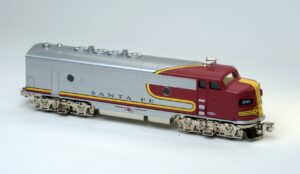
Menards Santa Fe O gauge locomotive program is underway. Asking some 200 people to take a chance on this new product is bold. To request they test it on their layouts and report what the maker got right — and more importantly, wrong — takes even more guts. It is something I’ve never heard of in the realm of model railroading.
But that’s what Midwest-based home-improvement chain Menards has done, releasing an O gauge Santa Fe EMD F unit diesel locomotive. The market was certainly interested: the entire run, offered on the company’s website, sold out in three hours.
I would rate this as the biggest toy train news story of the year, easily beating out the re-distribution of the MTH Trains product line and MTH continuing to produce trains. The buzz on this product has been far larger than its limited release would suggest.
A disclaimer: This is not a review. We are treating this model as a test shot with the assumption Menards is soliciting feedback to improve it for a future production run.
See the Menards F3 run on Bob’s Train Box 72.
Menards Santa Fe O gauge locomotive
This is a very good representation of an Electro Motive Division (EMD) cab unit. Menards markets it as an Santa Fe Diesel Locomotive, a satisfactory designation for most of the hobby. After all, it is a toy train, offered at a wallet-friendly $146.06.
Rivet counters will notice the fuel and water tanks under the midsection and steam generator exhaust on the roof, possibly outing it as a passenger-hauling FP7 or -9. Whatever it’s designated, it works for me!
The model has sound and lights and is controlled with a battery-powered hand-held remote. The operator must also have a standard variable A.C. transformer hooked to the track.
Apply power with the transformer and the model wakes up with a hearty diesel rumble. Turn on the controller and it syncs with the locomotive and responds to your commands. Simple and functional!
While incompatible with Lionel or MTH controls, the Menards F3 could probably be run independently with other command-equipped power on any line using 18V for track power.
Love the Santa Fe and this paint scheme?
Santa Fe locomotive body overview
The locomotive has the familiar EMD bulldog nose capped with a bright headlight. The sides of the cab have good cast-in detailing for handrails, rivets, steps, and a sand filler cap. I was particularly pleased to see three neatly painted silver kick plates below the cast-in door, and a couple of chrome horns adorn the roof.
There is what looks like a mold seam running up the nose behind the number boards and the cab windows, suggesting the shell was made from two pieces of tooling. I know I have seen this on some other model somewhere, but I checked all the cab units I own and couldn’t find a similar example.
The top of the shell is smooth, save for some lines that model removable maintenance access panels. There are four cast-in cooling fans and two solid exhaust stacks. On the rear you’ll find the previously mentioned equipment for the steam heating system.
There’s plenty of detail on the flanks, too, including simulated air intake grills along the top, “glazed” portholes, a cast-in sand-filler hatch, rivet detail, and a fuel tank cap and sight glass outlined in red paint. There is a second raised cap, which may be for filling the water tank. Absent are louvers that run horizontally between the windows of the prototype helping to identify the model.
I really liked the rear door! The frame is extended out from the body, and it appears as though it is solid, not just mimicking a diaphragm. The doorway has a porthole for the powerful backup light, a cast-in handle, and a cast in hinge attached to the frame. There are what appear to be cast-in grab irons on both sides of the door running upward.
Nice paint and detail
Painting and decoration are great and the Santa Fe livery is well executed. The lines between the silver to black to yellow to red were as sharp as it gets.
There’s a gap in the warbonnet paint where the louvers are, which some have pointed out as un-prototypical. However, photos of Santa Fe locomotives exist showing stripes painted over the louvers and others with a gap. At any rate, it certainly wouldn’t stop me from buying this model.
There are cast-in grab irons over the rear trucks and at the spot for the hostler controls. There are stirrups for crewmen to access both spots, on the frame and on the rear truck. Both are sturdy metal.
Down below, the trucks are good renderings of the Blomberg units that were standard on EMD’s F-series. They are die-cast metal with separate crew access stirrups attached. Both sets have thumbtack-style operating couplers. These functioned well and held nice and secure! The front- and rearmost sets of wheels are equipped with traction tires.
The locomotive frame is metal.
Menards locomotive’s radio control
The remote takes three AAA batteries and fits comfortably in adult- or child-sized hands. The front has the Santa Fe oval, the locomotive number, and a stylized “MRR” for Menards Railroad. The battery door has a photo of Jack the German shepherd.
A possible glitch: Some users have reported having to tweak the metal strips to make good contact with the batteries. This is easily done with a pair of needle-nose pliers or a flat-blade screwdriver before inserting the batteries.
A rotary knob controls forward and reverse movement as well as speed. There are buttons for activating the horn, crew talk, and the locomotive’s bell. The diesel engine sound is always on. However, its level, as well as the rest of the sounds, can be controlled by a volume wheel on the side, all the way down to nothing.
In the oval’s center is a red LED. It is red when power is on, and flashes when the controller is on, but the locomotive isn’t powered up. Think of it as a reminder to either turn off the controller, or to power up the track!
In practical terms, all the controls are easy to see and use and the locomotive is very responsive to commands. The remote seemed reliable over about a 25 x 30-foot area (I didn’t see a need to test it from the washing machine, in the far side of my basement!).
Throttle jockeying
You must apply track power before anything happens, just like other manufacturers’ control systems. Since there are no instructions with the model, I first cranked it up to 18V and got the locomotive rolling. After testing several power settings, I found the F3 needs at least 8V to run smoothly.
While the locomotive runs well, starting and stopping are abrupt. That might be attributable to the lack of flywheels on the can-style motors mounted on each truck.
The low-speed I captured was 16.6 scale miles per hour and the high speed was 46.4. I went back and checked the numbers for a conventional Lionel Santa Fe F3 in the December 1991 issue of Classic Toy Trains. The Lionel model’s low speed was 18.7 and the high speed was a curve jumping 172 scale miles per!
I ran the Menards F3 with both two-bulb heavyweight passenger cars and 24 mostly modern era freight cars. With the same speed setting the momentum looked pretty consistent to my eyes. If you want Duck Dodgers from the 24½ Century speeds, this may not be the engine for you. It runs at, shall we say, a more realistic pace.
Drawbar pull? Compared to the 1991 LTI F3’s 15 ounces, the Menards locomotive registered a solid 1 pound, 7 ounces. Pretty good for a test sample!
A tip to protect the engine from the grandkids: Set your transformer speed lower than 18 volts. It sets a “max” speed the kiddies can’t exceed with the hand-held unit.
Hats off to Menards
Competition is good, and Menards has shown it’s a feisty player in the world of model railroading. The company has been building a solid customer base while justifiably cautious about getting into the locomotive game.
The company gets high marks for basically saying, “test the heck out of these and tell us what you think.” But be reminded there is no guarantee this project will move forward. Additionally, if it does the production models could be at a different price point.
Only after the user feedback is in, and an analysis is made of what, if any, changes can or should be made, will the ball get in motion. At best, in today’s wacky world, we might see something in 12 months. But from my hands-on experience, it will certainly be worth the wait!





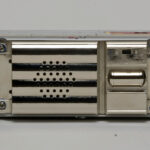
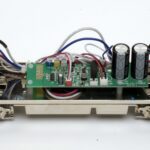
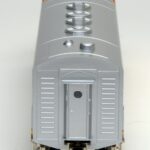
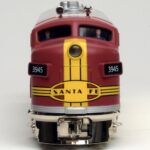
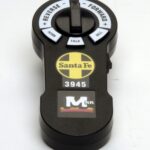









I assume by the write-up the F3 cannot be run in conventional mode. Is that correct or am I misinterpreting the overview?
It can be run WITH a conventional transformer (or, more accurately, it can be run on DC power, AC power, Lionel TMCC, Lionel Legacy, M.T.H. DCS, and any constant source of power that does not exceed 18 volts (and obviously isn’t something like 3 volts, because that wouldn’t be near enough) but ONLY controlled by the remote. However, since its speed is largely determined by the voltage applied to it, you can sort of run it with variable/conventional control until it doesn’t get enough power and the circuits cut out.
I am a California reader who has one major
issue with Menards, which is that this
company does not sell its products to
people in California. They claim that they
are afraid of running afoul of the State of
California Proposition 65, which is a voter
enacted statute that requires warnings for
cancer producing chemicals on items sold
in this State. Since all the Proposition
requires is a simple warning either in your
web site or on the packaging this is nonsense. Also the State has NO actual
enforcement tool in place for violations. I
note that Lionel, MTH, Atlas, Woodland
Scenics and all the other O gauge train
vendors sell their products here without
worry and full availability. Someone at
Menards must be wearing a tinfoil hat!
Please, Menards, be rational!
I think that they are concerned moreso as to whether or not it is considered to be a trouble making item. If you ask me, the safe bet would be to put it on everything: locos, freight cars, boards, wires, tomatoes, cats, floor tiles, ceiling tiles, wall tiles, cement tiles, salt, pepper, ballast, decorative rocks, and partridges and pears.
If they made this in a Boston and Maine I would buy it